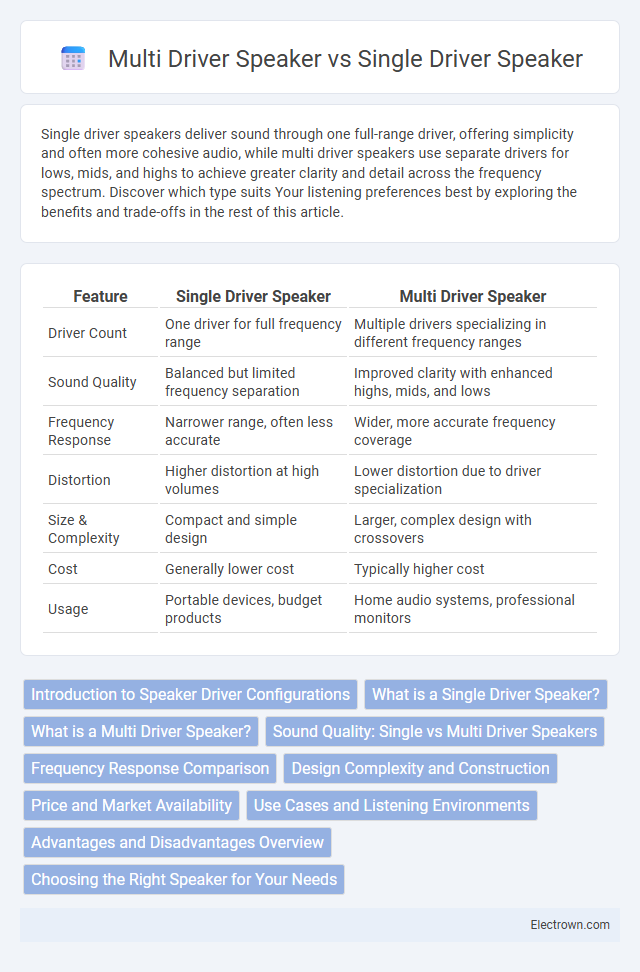Single driver speakers deliver sound through one full-range driver, offering simplicity and often more cohesive audio, while multi driver speakers use separate drivers for lows, mids, and highs to achieve greater clarity and detail across the frequency spectrum. Discover which type suits Your listening preferences best by exploring the benefits and trade-offs in the rest of this article.
Table of Comparison
| Feature | Single Driver Speaker | Multi Driver Speaker |
|---|---|---|
| Driver Count | One driver for full frequency range | Multiple drivers specializing in different frequency ranges |
| Sound Quality | Balanced but limited frequency separation | Improved clarity with enhanced highs, mids, and lows |
| Frequency Response | Narrower range, often less accurate | Wider, more accurate frequency coverage |
| Distortion | Higher distortion at high volumes | Lower distortion due to driver specialization |
| Size & Complexity | Compact and simple design | Larger, complex design with crossovers |
| Cost | Generally lower cost | Typically higher cost |
| Usage | Portable devices, budget products | Home audio systems, professional monitors |
Introduction to Speaker Driver Configurations
Single driver speakers utilize one full-range driver to cover the entire audio spectrum, offering coherence and simplicity in sound reproduction. Multi driver speakers separate frequencies across specialized drivers--such as woofers, midranges, and tweeters--to enhance clarity and frequency response. The choice between single and multi driver configurations impacts overall sound quality, efficiency, and design complexity in audio systems.
What is a Single Driver Speaker?
A single driver speaker uses one full-range driver to reproduce the entire audio spectrum, delivering sound from low to high frequencies through a single speaker cone. This design simplifies the internal components and often results in a more coherent and natural soundstage, ideal for listeners seeking clarity and uniformity in audio reproduction. Your choice of a single driver speaker can offer a warm, balanced listening experience without the complexity of crossover networks found in multi driver systems.
What is a Multi Driver Speaker?
A multi-driver speaker features multiple individual drivers, such as woofers, mid-range, and tweeters, each specialized in reproducing different frequency ranges to deliver a more accurate and balanced sound. This design allows you to experience enhanced clarity and depth compared to a single driver speaker, which uses only one driver to handle the entire audio spectrum. Multi-driver speakers are ideal for achieving precise sound separation and richer audio detail in your listening environment.
Sound Quality: Single vs Multi Driver Speakers
Single driver speakers produce sound through one full-range driver, delivering a cohesive audio experience with fewer phase issues but potentially limited frequency response and less detail in highs or lows. Multi driver speakers use separate drivers for bass, mids, and treble, allowing for clearer sound reproduction, enhanced detail, and a wider frequency range by optimizing each driver's performance for specific audio frequencies. Your choice depends on whether you prioritize simplicity and uniform sound or detailed, rich audio with precise separation across the sound spectrum.
Frequency Response Comparison
Single driver speakers typically offer a more cohesive frequency response with a natural transition across low, mid, and high ranges, but may struggle to reproduce extreme highs and lows with precision. Multi driver speakers use dedicated drivers for bass, midrange, and treble, providing a wider frequency response and greater clarity in each range, resulting in more accurate sound reproduction. Your choice depends on whether you prioritize seamless sound integration or extended frequency range and detail.
Design Complexity and Construction
Single driver speakers feature a straightforward design with one full-range driver handling all frequencies, resulting in simpler construction and fewer components. Multi driver speakers incorporate separate drivers--woofers, midranges, and tweeters--requiring complex crossovers and precise engineering to balance sound across the frequency spectrum. Your choice impacts not only sound performance but also the intricacy and cost of the speaker's construction process.
Price and Market Availability
Single driver speakers generally have a lower price point due to simpler design and fewer components, making them widely accessible across budget-friendly and entry-level markets. Multi driver speakers, featuring separate drivers for different frequency ranges, tend to command higher prices and are more prevalent in mid to high-end audio segments targeting audiophiles and professionals. Market availability for single driver speakers is vast across online retailers and consumer electronics stores, whereas multi driver models are often found in specialty audio shops and premium e-commerce platforms.
Use Cases and Listening Environments
Single driver speakers offer simplicity and coherence, making them ideal for smaller listening spaces like bedrooms or offices where clear midrange and vocal reproduction are prioritized. Multi driver speakers excel in larger rooms or home theater setups by separating frequencies across dedicated drivers, delivering enhanced bass, midrange, and treble clarity for immersive soundscapes. Depending on Your environment and audio needs, choosing between single and multi driver systems ensures optimized performance and listening satisfaction.
Advantages and Disadvantages Overview
Single driver speakers offer simplicity and coherent sound reproduction, benefiting from a single diaphragm covering the entire frequency range, which reduces phase distortion and ensures uniform tonal balance. However, they often struggle with frequency response limitations, lacking the capability to accurately reproduce deep bass and crisp highs compared to multi driver speakers. Multi driver speakers separate bass, midrange, and treble duties across dedicated drivers, enabling improved frequency specialization and dynamic range but at the cost of potential phase issues and increased design complexity.
Choosing the Right Speaker for Your Needs
Single driver speakers provide a unified sound source, delivering consistent audio quality with fewer phase issues, ideal for compact setups or budget-conscious users. Multi driver speakers separate frequencies across specialized woofers, midranges, and tweeters, offering enhanced clarity and dynamic range for audiophiles or home theater enthusiasts. Understanding your listening environment and audio preferences helps you choose the right speaker that balances performance, budget, and space requirements effectively.
single driver vs multi driver speaker Infographic

 electrown.com
electrown.com